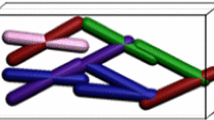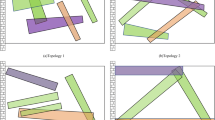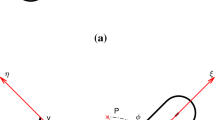Abstract
Topology optimization provides a powerful approach to structural design with its capability to find the optimal topology automatically. However, the optimal topologies achieved by the traditional density-based method are difficult to be manufactured. Recently, some explicit descriptions, like the Moving Morphable Components (MMC) approach, have been introduced to narrow the gap between design and manufacture. However, since only components with simple geometry are considered, it is still unsatisfactory regarding geometric arbitrariness in those studies. Here we demonstrate a new topology optimization approach originating from the MMC framework by replacing the straight components with the curved ones so as to enhance the geometric arbitrariness. The skeleton of the modified component is described by the non-uniform rational B-splines (NURBS) curve. The concept of time series is then proposed to directly generate the curved component from the 1D skeleton curve. It is shown that it’s much easier to achieve the variation of width by the new strategy when compared with other curve descriptions. Numerical examples demonstrate the effectiveness and robustness of the proposed approach based on the moving morphable curved components.












Similar content being viewed by others
References
Allaire G, Jouve F, Toader A-M (2004) Structural optimization using sensitivity analysis and a level-set method. J Comput Phys 194:363–393. https://doi.org/10.1016/j.jcp.2003.09.032
Bendsøe MP (1989) Optimal shape design as a material distribution problem. Struct Optim 1:193–202. https://doi.org/10.1007/BF01650949
Bendsøe MP, Kikuchi N (1988) Generating optimal topologies in structural design using a homogenization method. Comput Methods Appl Mech Eng 71:197–224. https://doi.org/10.1016/0045-7825(88)90086-2
Bhat KV, Capasso G, Coniglio S, Morlier J, Gogu C (2022) On some applications of generalized geometric projection to optimal 3D printing. Comput Graph 102:199–212. https://doi.org/10.1016/j.cag.2021.10.006
Coniglio S, Morlier J, Gogu C, Amargier R (2020) Generalized geometry projection: a unified approach for geometric feature based topology optimization. Springer, Netherlands
Cox MG (1972) The numerical evaluation of B -splines. IMA J Appl Math 10:134–149. https://doi.org/10.1093/imamat/10.2.134
de Boor C (1972) On calculating with B-splines. J Approx Theory 6:50–62. https://doi.org/10.1016/0021-9045(72)90080-9
Guo X, Zhang W, Zhong W (2014) Doing topology optimization explicitly and geometrically-a new moving morphable components based framework. J Appl Mech Trans ASME 81:1–12. https://doi.org/10.1115/1.4027609
Guo X, Zhang W, Zhang J, Yuan J (2016) Explicit structural topology optimization based on moving morphable components (MMC) with curved skeletons. Comput Methods Appl Mech Eng 310:711–748. https://doi.org/10.1016/j.cma.2016.07.018
Hu X, Bao R, Chen W (2020) Enhance the sensitivity of strain-gauge-based force sensors using moving morphable units method. Struct Multidisc Optim 62:2805–2816. https://doi.org/10.1007/s00158-020-02631-2
Hu X, Bao R, Chen W, Wang H (2021) Robust optimal design of strain-gauge-based force sensors using moving morphable components method: enhanced sensitivity and reduced cross-interference. Struct Multidisc Optim 64:1439–1455. https://doi.org/10.1007/s00158-021-02929-9
Huang X, Xie YM (2009) Bi-directional evolutionary topology optimization of continuum structures with one or multiple materials. Comput Mech 43:393–401. https://doi.org/10.1007/s00466-008-0312-0
Jang KI, Chung HU, Xu S, Lee CH, Luan H, Jeong J, Cheng H, Kim GT, Han SY, Lee JW, Kim J (2015) Soft network composite materials with deterministic and bio-inspired designs. Nat Commun 6:1–11. https://doi.org/10.1038/ncomms7566
Jiang X, Liu C, Du Z, Huo W, Zhang X, Liu F, Guo X (2022) A unified framework for explicit layout/topology optimization of thin-walled structures based on moving morphable components (MMC) method and adaptive ground structure approach. Comput Methods Appl Mech Eng 396:115047. https://doi.org/10.1016/j.cma.2022.115047
Kennedy GJ, Hicken JE (2015) Improved constraint-aggregation methods. Comput Methods Appl Mech Eng 289:332–354. https://doi.org/10.1016/j.cma.2015.02.017
Liu C, Zhu Y, Sun Z, Li D, Du Z, Zhang W, Guo X (2018) An efficient moving morphable component (MMC)-based approach for multi-resolution topology optimization. Struct Multidisc Optim 58:2455–2479. https://doi.org/10.1007/s00158-018-2114-0
Ma Q, Zhang Y (2016) Mechanics of fractal-inspired horseshoe microstructures for applications in stretchable electronics. J Appl Mech Trans ASME. https://doi.org/10.1115/1.4034458
Ma Q, Cheng H, Jang KI, Luan H, Hwang KC, Rogers JA, Huang Y, Zhang Y (2016) A nonlinear mechanics model of bio-inspired hierarchical lattice materials consisting of horseshoe microstructures. J Mech Phys Solids 90:179–202. https://doi.org/10.1016/j.jmps.2016.02.012
Svanberg K (1987) The method of moving asymptotes—a new method for structural optimization. Int J Numer Methods Eng 24:359–373. https://doi.org/10.1002/nme.1620240207
Wang MY, Wang X, Guo D (2003) A level set method for structural topology optimization. Comput Methods Appl Mech Eng 192:227–246. https://doi.org/10.1016/S0045-7825(02)00559-5
Wein F, Dunning PD, Norato JA (2020) A review on feature-mapping methods for structural optimization. Struct Multidisc Optim 62:1597–1638. https://doi.org/10.1007/s00158-020-02649-6
Xie YM, Steven GP (1993) A simple evolutionary procedure for structural optimization. Comput Struct 49:885–896. https://doi.org/10.1016/0045-7949(93)90035-C
Xue R, Liu C, Zhang W, Zhu Y, Tang S, Du Z, Guo X (2019) Explicit structural topology optimization under finite deformation via Moving Morphable Void (MMV) approach. Comput Methods Appl Mech Eng 344:798–818. https://doi.org/10.1016/j.cma.2018.10.011
Zhang W, Yuan J, Zhang J, Guo X (2016) A new topology optimization approach based on Moving Morphable Components (MMC) and the ersatz material model. Struct Multidisc Optim 53:1243–1260. https://doi.org/10.1007/s00158-015-1372-3
Zhang W, Yang W, Zhou J, Li D, Guo X (2017) Structural topology optimization through explicit boundary evolution. J Appl Mech 84:1–10. https://doi.org/10.1115/1.4034972
Zhang S, Gain AL, Norato JA (2018) A geometry projection method for the topology optimization of curved plate structures with placement bounds. Int J Numer Methods Eng 114:128–146. https://doi.org/10.1002/nme.5737
Zhou M, Rozvany GIN (1991) The COC algorithm, part II: topological, geometrical and generalized shape optimization. Comput Methods Appl Mech Eng 89:309–336. https://doi.org/10.1016/0045-7825(91)90046-9
Zhou Y, Zhu J, Zhan H, Zhang W, Gu Y (2021) A bio-inspired B-spline offset feature for structural topology optimization. Comput Methods Appl Mech Eng 386:114081. https://doi.org/10.1016/j.cma.2021.114081
Zhu B, Chen Q, Wang R, Zhang X (2018) Structural topology optimization using a moving morphable component-based method considering geometrical nonlinearity. J Mech Des Trans ASME 140:1–10. https://doi.org/10.1115/1.4040547
Zhu B, Wang R, Wang N, Li H, Zhang X, Nishiwaki S (2021) Explicit structural topology optimization using moving wide Bezier components with constrained ends. Struct Multidisc Optim 64:53–70. https://doi.org/10.1007/s00158-021-02853-y
Zhu B, Wang R, Liang J, Liang J, Lai J, Zhang H, Li H, Li H, Nishiwaki S, Zhang X (2022) Design of compliant mechanisms: An explicit topology optimization method using end-constrained spline curves with variable width. Mech Mach Theory 171:104713. https://doi.org/10.1016/j.mechmachtheory.2021.104713
Acknowledgements
The work was jointly supported by the Natural Science Foundation of Zhejiang Province (No. LD21A020001) and the National Natural Science Foundation of China (Nos. 12192211, 12192110 and 11872329). Partial support from the Shenzhen Scientific and Technological Fund for R&D, PR China (No. 2021Szvup152) is also acknowledged.
Author information
Authors and Affiliations
Corresponding author
Ethics declarations
Conflict of interest
The authors declare that they have no conflict of interest.
Replication of results
All the results in this paper are generated by our MATLAB codes. The source codes can be available from the corresponding author with reasonable requests.
Additional information
Responsible Editor: Julián Andrés Norato
Publisher's Note
Springer Nature remains neutral with regard to jurisdictional claims in published maps and institutional affiliations.
Appendix: Library of benchmark examples
Appendix: Library of benchmark examples
To further show the good performance of the developed TSMMC, several representative examples are provided in this library.
The Messerschmitt–Bölkow–Blohm (MBB) problem is illustrated in Fig.
13. Because of the symmetry, the design domain is taken to be half of the beam. The vertical load is applied on the middle point of the top side with \(F = 1\). The length and height of the design domain are taken to be 3 and 1 with a \(120 \times 40\) FEM mesh. The upper bound of the available volume is set as \(V_{bound} = 0.5\). The configuration is composed of 12 curved components, and 6 control points are assigned to draw each component. Figure
14 shows the initial configuration, optimized configuration, and convergence history.
The second example is the bridge problem as shown in Fig.
15. \(150 \times 50\) FEM mesh is assigned to the \(3 \times 1\) design domain and a \(3 \times 0.1\) non-designable domain is set on the top. The load is uniformly distributed on the top surface with the total magnitude equal to 1. The upper bound of the available volume of this problem is taken as \(V_{bound} = 0.3\). The numbers of components and control points are 8 and 6, respectively. The convergence history with its initial and final configurations of this bridge problem is illustrated in Fig.
16. Noted that some curved components are clearly seen in the optimized configuration which clarifies the need of using curved components in MMC.
The Michell truss problem for a single load with two supports (Fig.
17) is considered here. The \(2 \times 1\) rectangular design domain is meshed by \(100 \times 50\) finite elements. A vertical load \(F = 1\) is applied on the middle point of the bottom side. As in the previous case, the numbers of components and control points are 8 and 6, respectively. The volume constraint of this problem is set to be \(V_{bound} = 0.4\). The convergence history with its initial and final configurations is shown in Fig.
18. The optimization converges very fast and the curved components are also seen in the optimized configuration. The jump is due to the fact that voids temporarily exist near the force-applied region. Actually, such a problem is also reported in the standard MMC-based framework (Zhu et al. 2018).
The Michell truss problem for a single load with a circular support (Fig.
19) is also considered here for demonstrating the advantages of TSMMC. The \(3 \times 2\) rectangular design domain is meshed by \(120 \times 80\) elements. A vertical load \(F = 1\) is applied at the centre of the right boundary. The numbers of components and control points for each component are set as 2 and 6, respectively. The volume constraint of this case is \(V_{bound} = 0.25\). The convergence history with its initial and final configurations is shown in Fig. 19. It converges fast. Curved components are seen in the optimized configuration which exactly implies the advantages of TSMMC.
Finally, we return to the short beam problem again. Given an initial configuration without symmetry, we examine whether the TSMMC can spontaneously generate a symmetric design. All parameters are set to be the same as before except for the initial configuration. The convergence history with its initial and final configurations is shown in Fig. 20. As observed from Fig. 21, the components can find their optimal shapes and positions even when an asymmetric initial configuration is adopted.
Rights and permissions
Springer Nature or its licensor (e.g. a society or other partner) holds exclusive rights to this article under a publishing agreement with the author(s) or other rightsholder(s); author self-archiving of the accepted manuscript version of this article is solely governed by the terms of such publishing agreement and applicable law.
About this article
Cite this article
Li, Z., Hu, X. & Chen, W. Moving morphable curved components framework of topology optimization based on the concept of time series. Struct Multidisc Optim 66, 19 (2023). https://doi.org/10.1007/s00158-022-03472-x
Received:
Revised:
Accepted:
Published:
DOI: https://doi.org/10.1007/s00158-022-03472-x













